Balancing Tradition and Technology
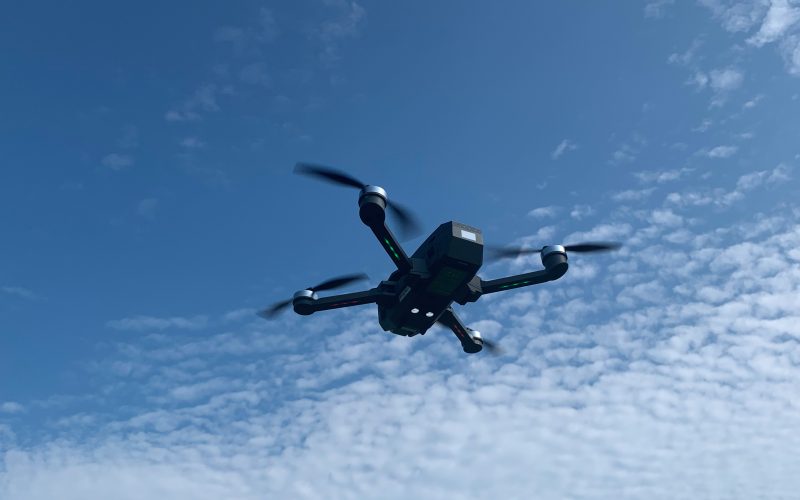
Tristin Smith is a research assistant at the University of Michigan’s Center for Local, State, and Urban Policy (CLOSUP), where she works on the Center’s “Close Up on the UP” project. She is a senior in the School of Information majoring in Information Analysis and minoring in Digital Studies and is part of the U.P. Scholars Program.
“CLOSEUP on the UP” is a collaboration between CLOSUP, U-M’s UP Scholars Program, and Rural Insights.
Just like the perfect pair of peanut butter and jelly, technology and change go hand in hand with one another. Change is inevitable, and even in the U.P. we must adjust, adapt, and accommodate, especially when it can make our towns safer. From my own experience, the U.P. can sometimes feel a step behind the curve when it comes to adopting new trends or products. For example, Amazon deliveries would take two or three days while I lived in the U.P., compared to the same-day or next-day delivery that I experience now living downstate.
Yet in some areas, such as law enforcement, technology adoption has followed a different trajectory. As shown in Figure 1, over the past decade, technology adoption has grown significantly in the U.P., often keeping pace with – or even exceeding – similar developments in the Lower Peninsula. These investments aren’t just about modernization; they directly shape safety in our small towns and rural communities. At the state level, for instance, Michigan State Police troopers are now required to operate body-worn cameras if they could have law enforcement contact with the public, demonstrating how technology is being integrated into everyday policing to improve both safety and accountability.
Figure 1
Percentage of Michigan local government officials who reported use of various camera and surveillance equipment by their primary law enforcement agency in 2024
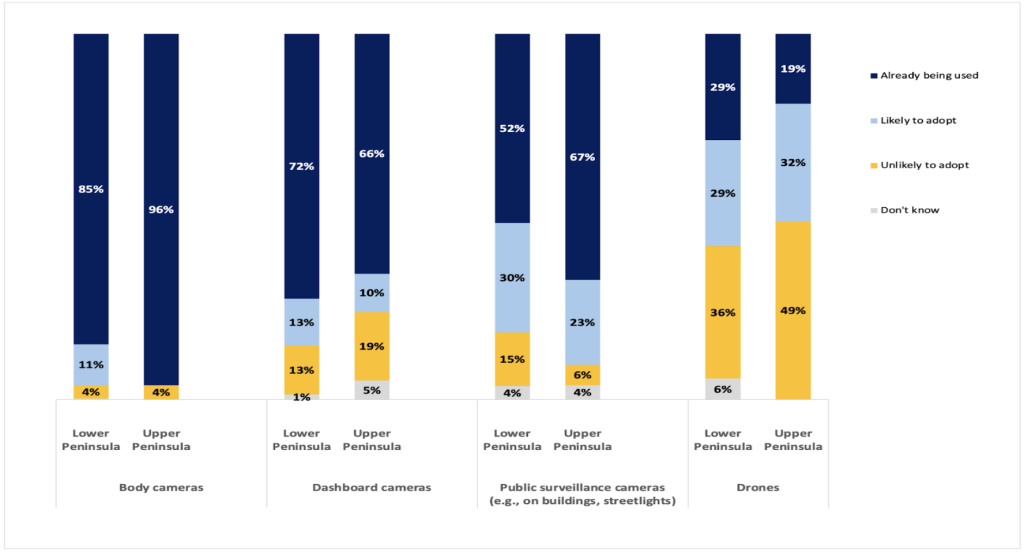
Source: The Michigan Public Policy Survey (MPPS), Spring 2024 (https://closup.umich.edu/michigan-public-policy-survey)
To understand how far the U.P. has come in adopting law enforcement technology, we can look at the change over the past decade. According to local government leaders in the U.P., as shown in Figure 2 below, the adoption of body cameras, dashboard cameras, public surveillance cameras, and drones have increased significantly in the past 10 years. These data come from a survey on criminal justice and policing policies in Michigan that included county officials, as well as officials from cities, villages, and townships that either run their own police departments, share services with another jurisdiction, or contract for law enforcement services provided by a special authority or district, by another municipality, or through a contract with their county sheriff.
Figure 2
Percentage of U.P. local government officials who reported use of various camera and surveillance equipment by their primary law enforcement agency (among U.P. local governments that provide law enforcement services directly or indirectly), 2015 vs. 2024
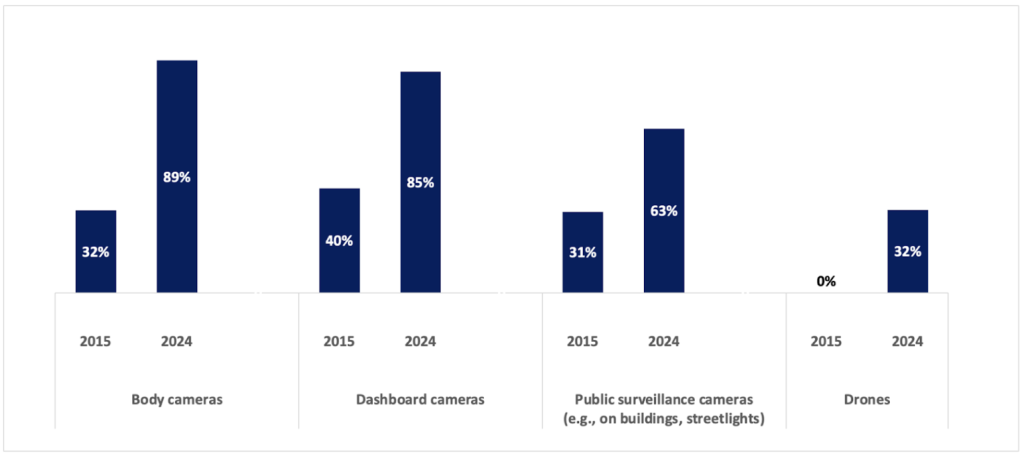
Source: The Michigan Public Policy Survey (MPPS), Spring 2024 (https://closup.umich.edu/michigan-public-policy-survey)
You might be thinking that this change would be expected within a nine-year timeframe, but I think there are some things to mention. Part of this growth can likely be attributed to increased calls for accountability and transparency, especially around body-worn cameras. Part of the growth may be the result of the fact that these technologies have become more affordable and more widely available.
Figure 3 shows responses to newer survey questions that were only asked in 2024, focusing on technologies that weren’t on the radar back in 2015. Here we can see that some communities in the U.P. are already beginning to adopt tools such as automated license plate readers, though usage of facial recognition technology and predictive policing tools are still limited. What stands out to me is the limited use of artificial intelligence (AI). While the results could be different now, a year or so later, I believe that the integration of these tools are necessary.
Figure 3
Percentage of U.P. local government officials who reported use of newer camera and surveillance equipment by their primary law enforcement agency (among U.P. local governments that provide law enforcement services directly or indirectly), 2024
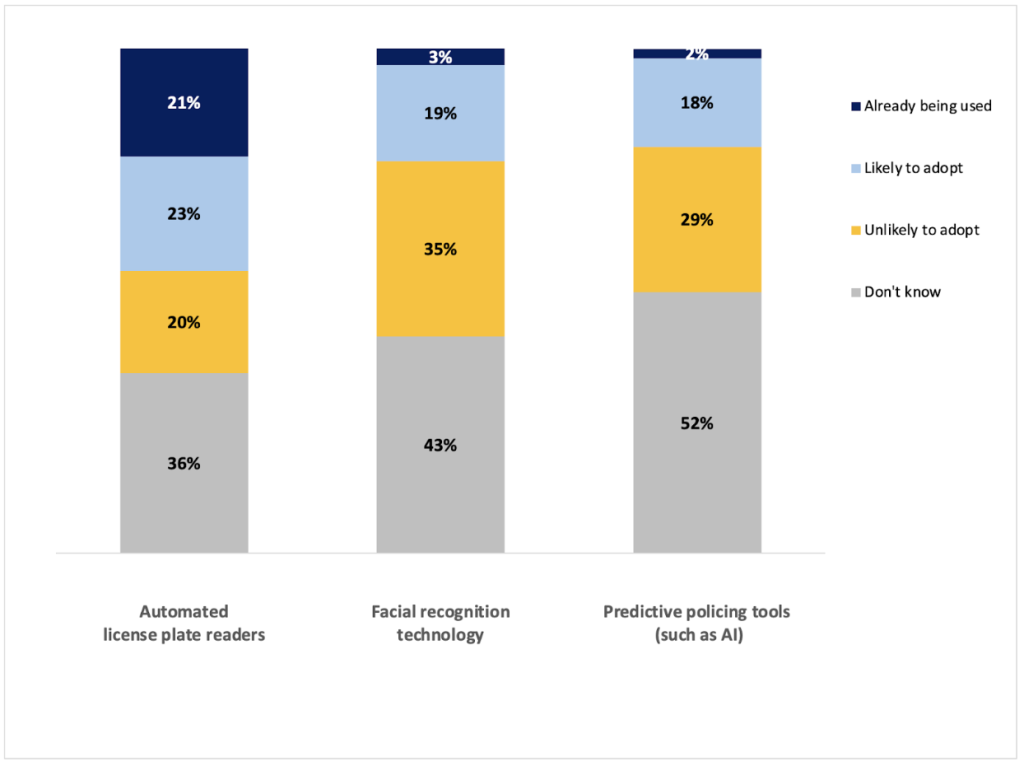
Source: The Michigan Public Policy Survey (MPPS), Spring 2024 (https://closup.umich.edu/michigan-public-policy-survey)
The lack of adoption surrounding AI could reflect budget limits and general unfamiliarity with the technology, but I think it also speaks to ethical concerns and the realities of policing in rural areas. While AI poses security risks surrounding the confidentiality of inmates, employees, and other things, I think utilizing this technology is key for moving forward. For smaller towns these advanced technologies may not feel necessary, or they may raise more questions than answers. It is one thing for an individual to wear a visible body camera for transparency purposes, it is another thing to scan faces in a community where essentially, everyone already knows each other. I can assume U.P. local government officials are still cautious about which innovations are appropriate for our rural communities. Still, I believe it’s worth considering whether every dollar spent on new equipment is the best investment for public safety. I believe that some communities may benefit just as much, if not more, from investing in other things such as mental health resources or even additional social workers.
Figure 4
U.P. local leaders’ assessments of whether technology use is worthwhile investment for their community (among units that report using each type of technology), 2024
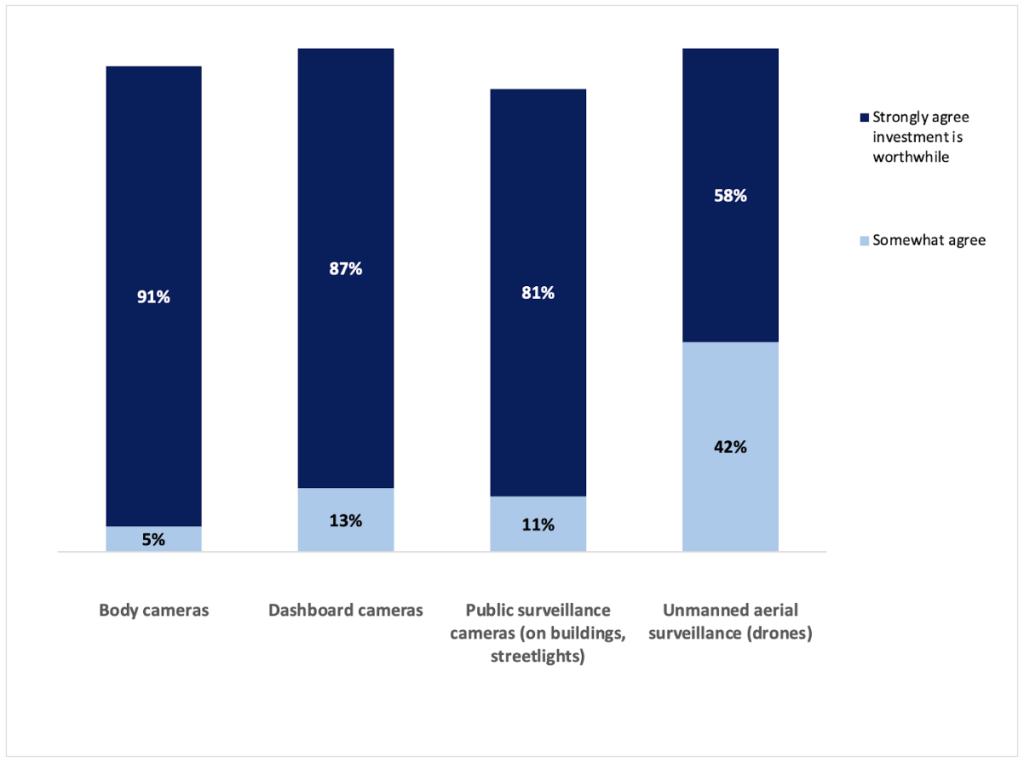
Source: The Michigan Public Policy Survey (MPPS), Spring 2024 (https://closup.umich.edu/michigan-public-policy-survey)
Figure 4 demonstrates that the majority of U.P. local government officials strongly agree that the investment for various technologies are worthwhile. Leaders who already use body cameras, dashboard cameras, or drones can clearly see the value in utilizing these technologies for safety and accountability. This trend suggests that once local governments make the initial investment, the benefits become apparent quickly, which I believe reinforces confidence in the decision. Still, I think it is worth noting that perceptions of “worthwhile” are subjective based on community needs. For example, what feels like a strong return on investment for a larger community may look different for a smaller community that experiences fewer incidents involving law enforcement. These differences highlight the importance of tailoring technology adoption to fit a local community rather than a “one size fits all” approach. Ultimately, the survey results show that local government leaders in the U.P. are in favor of these tools being used as assets. But, the effectiveness of said tools will continue to depend on how they are implemented, adopted, and supported at a community level.
Growing up in Rudyard, I knew most of the police officers in my community by name. They were the same people I’d see at my school, at the grocery store, or driving down main street. Some of them were my friends’ relatives or even related to me. That kind of familiarity creates an environment that creates a level of trust that no piece of technology can replace. While AI, body cameras, security cameras, and drones can add layers of accountability and efficiency, they cannot substitute for the relationships that keep rural communities safe like mine. For places in the U.P., the challenge isn’t only deciding which technologies are worth the investment – it is also making sure that these tools will enhance the human connections that already exist, rather than replace them. In my opinion, moving forward, the most meaningful investments will be the ones that strengthen the bond between both technology and people. I hope that the integration of these technologies will keep the close-knit character of our small towns in the U.P. at the heart of public safety.





When my father was in the MSP IN THE 1960s, they were quick to adopt both radar units and computers in their patrol cars. Not as sophisticated as today, but a start at technology integration. Dad always reminded us that no matter how souped up and fast a car might be, fleeing the MSP was not wise. Radio waves were always faster than any vehicle
Wonderful thoughts here, Tristin, about the importance of using technology to enhance our human connections and ensuring we’re using a tailored approach that makes sense for our rural communities. Thanks for this insightful read!
Very interesting article – amazing the benefits technology can provide to law enforcement.
Tad
believe drones are an invasive tool however ,they could be very beneficial for search and rescue issues… privacy should always be a consideration … plate readers and body and dashboard cameras are probably a good idea .. don’t care for the facial recognition system .. it’s used and abused in china .. so it’s very iffy ..artificial intelligence could also be very problematic
Government will eventually need to feed on each, and monitor thinking when they have sucked their populations dry.
And no longer needs the humanity that God has put here created as “free choice” beings/individuals.
This is not Godly but the plans of the ungodly among us.
The gaping wound in America’s national security is without a doubt, the unregulated dragnet surveillance of AI.
Surveillance shouldn’t be the tradeoff for any damn service we get.”
Or the fools that choose to allow my God given free choice, to be taken away in the option of conveince and their argument that we must be less as individuals so that they may be more as a group!??
That’s what’s new.
There used to be the option of opting out. But now that’s over. Completion is the end. We’re closing the circle around everyone—it’s a totalitarian nightmare.”
Odd assumption that video surveillance of regular citizens using license plate readers and facial recognition is a good thing. Where is the discussion of privacy rights? Government overreach? Data handling by third parties? Length and security of data storage? All over the country we see that data is mis-handled, and in the current day and age, misused to suppress political opposition. By all means, let’s not add the potential nightmares of AI surveillance and errors to the mix.
100% agree.
Talk to me about privacy and government overreach when one of your family members goes missing and might be the victim of a heinous crime. In my view, if I’m not up to something illegal, it shouldn’t matter if Uncle Sam and his associates can track me. LEOs would get bored watching me for long. Anyway, I feel safer.
“Those who would give up essential Liberty, to purchase a little temporary Safety, deserve neither Liberty nor Safety.” Ben Franklin
Hey Michelle well spoken and some guy named Ben Franklin, your a student of history and a educated thoughtful pleasant breath of fresh air,
Thank You
And to Nick Barron a fool and his freedom can be soon separated ….
So you be the first fool to sign up for the GOVERNMENT SURVELEINCE PROGRAM!!
As for me and mine were not going to follow your ignorant ass into the program you so evidently support!
One more question not for Nick Barron but for my fellow hoopers?
Ever notice how these ignorant dopes disappear or are never heard from in any public setting where they can be identified by their warped thinking and words ??
Show up in a public forum and show the world who you are, and perhaps out from under the rocks these types love to live under.
SOME WOULD CALL IT COWARDICE.
But the challenge stands any public forum come show your face
and have a real discussion.
One last question, last year at this time MAGA signs, pickup trucks with American and Confederate flags everywhere and oh Maga Hats all cool.
But where I lived up here they stayed for years and years after the GOVERNMENT INSURECTION January 6th 2020.
Like ticks on dogs these types loud and proud 😉
But today as I look around my UP community banners have disappeared Trump flags that flew for years and years seem to be doing the same???? Hmmm
So my question to my fellow yoopers , what do you suppose is going on in the minds of the LOUD & PROUD MAGA CROWD TODAY.
The same people who voted this national nightmare/insurrection upon what was once called “The Light Upon the Hill, America.
When hate Trumps love of country and neighbors seems to me Loud and Proud Maga neighbors become just another rat in the corn-crib.
YOU OWN THIS MY MAGA NEIGHBOR.
And the true shame and loss of American values is on you!
AND WE ALL SAW EVERYONE OF YOU QUIET COWARDS